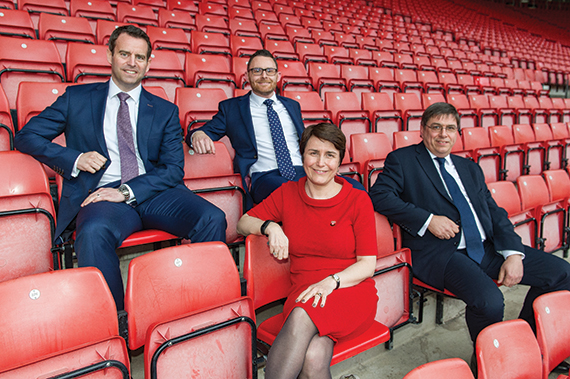
Large-scale regeneration, how to attract inward investment, and the state of the city’s office and residential markets were some of the hot topics debated at the £33m St Mary’s Stadium, home of Premier League Southampton football club and the first ever Estates Gazette City Talks event.
Southampton has a good story to tell, with an ambitious £3bn masterplan for the city centre and £1.6bn already invested in regeneration. Large-scale sites have started to come forward such as Inland Homes’ Chapel Riverside and Lucent Group’s Royal Pier, but they are not without hurdles.
Paul Brett, land director at Inland Homes and one of the event’s panellists, says the developer has been working very closely with the city council on the project for the past 18 months and admits to having to deal with “some very significant challenges” with the regeneration project.
He says: “The vision remains to create a new mixed-use community with up to 500 new homes, retail and a marine focus to the office content.
“It is a complex site with significant remediation works required and a new sea wall and flood defences needed. There is comfortably over £12m of costs associated with it before we get it out of the ground.”
With these challenges and more to overcome, Brett says: “It’s a challenging site, but we’re impressed with Southampton as a city and its vision. Southampton has an enormously ambitious masterplan which many were cynical about, but huge progress has already been made.”
Southampton’s other large, waterfront project is the £450m Royal Pier development, a mixed-use scheme by Lucent Group, which will include 500,000 sq ft of offices along with restaurants, shops and 730 homes. The site could also contain a casino, five-star hotel, spa and parking.
The aim is to make the project a globally recognised waterfront destination and Martin Judd, fellow panelist and director at AECOM, cites projects such as Sydney’s Darling Harbour as inspiration for the wider regeneration of Southampton’s waterfront.
“We want to draw people in and look at how we can get them to stay here for weekend breaks. We probably do not currently make enough of our waterfront location in Southampton. But the vision is there and developers and funders are interested.”
The public sector role in any such developments should be to help de-risk private sector proposals and to facilitate dialogue between partners.
Dawn Baxendale, chief executive at the council and fellow panellist, says the council will be inventive, and wants to talk with prospective partners at an early stage. “It has been a long journey, but as a council, we cannot regenerate Southampton in isolation. No matter what the difficulties are, we all have to find solutions to make sites work,” she says.
“Now we need to pick up the pace and decide: where do we go next with our ambitions for the city?”
In the office sector, a shortage of quality, available office space in the city centre and a lack of development sites is starting to pinch.
With take-up increasing 87% year-on-year, average office rents up by 12% from 2014 to 2015, and less than three years of office stock left at the current absorption rate – according to the latest EGi research – attention now needs to be turned to building new office space.
Panellist Martin Hastelow, head of the Southampton office of Savills, says that space has dwindled significantly – mainly due to PDR – which is a problem.
“There is circa 200,000 sq ft of available space on the market at the moment. If you compare this to historic availability rates back in 1995, which were 670,000 sq ft, you can see there is a big difference. Stock is pretty tight and there needs to be a readjustment,” he says.
Hastelow would like to see new office development and believes there is developer appetite for it. “With rents at £18-£19 per sq ft, possibly £20 per sq ft on refurbs, growth rates on rents are some of the highest in the country here, why can’t we build something new?”
However, the next issue for the city is where to put new office development, as there is a lack of large office development sites available and stiff competition from residential and student accommodation developers looking to cash in on the city’s buoyant housing market.
Southampton key facts
239,400
Population
87%
growth in GVA between 2010-2014
£1.2bn
total GVA. Southampton is Europe’s most productive port and can handle the largest container vessels in the world
1%
The University of Southampton is in the top 1% of universities worldwide. The inventor of the world wide web, Sir Tim Berners-Lee, is chair of computer science in electronics at the University
£33M
spent to date on Southampton FC’s Staplewood campus, rising to £40m
Source: Invest in Southampton and the Tech Nation report
Winners take it all
A business card draw at the event saw four winners each win two tickets for an executive box at a Southampton FC match (to be announced upon the release of fixtures) during the 2016/2017 season.
The winners are
Paul Conway, Architecture PLB
Mark Sennitt, Orchard Homes
Adam Anderson, Hyperoptic
John Fox, AECOM


















